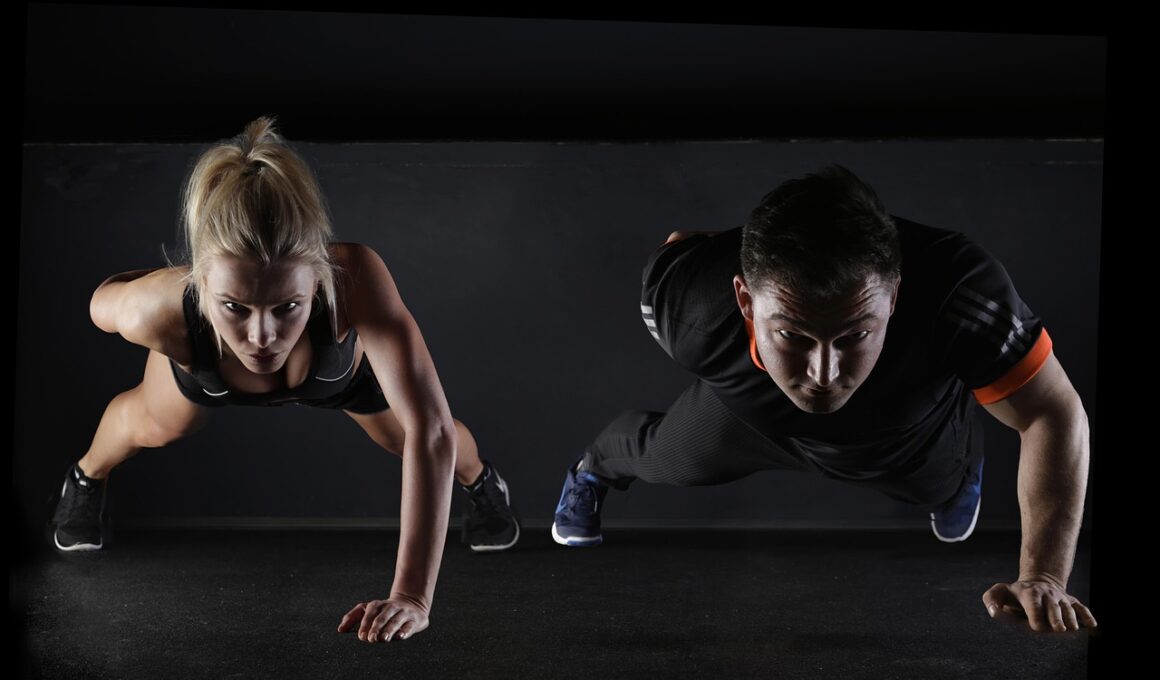Strength Training Adaptations for Clients with Disabilities
Strength training is crucial for individuals with disabilities, enhancing physical fitness and overall well-being. When designing training programs, one must consider various adaptations to accommodate specific needs. These adaptations ensure safety and promote effective strength gains. Adaptive fitness coaches must assess each client’s unique abilities, taking into account any limitations or barriers they may have. One effective strategy is to modify standard exercises to cater to a client’s specific condition. For instance, using resistance bands can provide a lower-impact alternative to free weights, enabling clients to work on strength without excessive strain. Additionally, it is essential to focus on building a supportive environment where clients feel comfortable expressing their needs. Consistent communication regarding progress, preferences, and challenges is vital in fostering successful training experiences. Coaches should also prioritize inclusive equipment and facilities that enhance accessibility and comfort. Engaging with clients about their personal goals will ensure that training remains relevant and motivating. This approach not only fosters long-term commitment but also helps in the achievement of mental and physical health objectives. Ultimately, these adaptations help empower individuals with disabilities, fostering independence and confidence in their personal fitness journeys.
Understanding Individual Needs
Understanding the unique needs of clients with disabilities is essential in developing effective strength training programs. Working closely with each individual allows coaches to identify specific goals and obstacles that may arise during training sessions. Regular assessments help in tailoring exercises to fit a client’s strengths and limitations adequately. Adaptations can include changes to exercise duration, intensity, or even specific movement patterns, ensuring the training is both safe and impactful. Encouraging self-advocacy among clients plays a crucial role as well. Clients often have insights about what movements feel comfortable or challenging for them, which can inform program designs. Furthermore, establishing realistic, achievable goals with clients fosters motivation and commitment to their fitness journeys. Strength training should not be a one-size-fits-all approach; rather, it deserves careful consideration of each client’s individual perspective. In this context, using assistive devices can significantly enhance a client’s participation and success rate. For instance, modified grips or the use of adaptive equipment can facilitate the execution of exercises that traditionally might pose challenges. Ultimately, being aware of individual needs enables professionals to create a highly personalized fitness experience that empowers clients to thrive.
Engaging clients with disabilities in strength training requires a holistic perspective. It’s important to recognize the physical, emotional, and social dimensions that enhance the effectiveness of a fitness program. Building a rapport based on trust is fundamental in the trainer-client relationship. This trust enables individuals to communicate openly, ensuring that the coach can make necessary adjustments for optimal training outcomes. Coaches might also include family members or caregivers in consultations, thereby providing support and understanding from a broader context. Incorporating social elements into training can also enhance motivation and enjoyment. Group sessions or partner workouts can create a supportive atmosphere where clients encourage one another. Implementing games or challenges can also foster engagement and increase participation levels. Adherence to a well-structured program can lead to measurable improvements in strength, stamina, and confidence. Another essential factor is ensuring that the training is progressive, allowing clients to gradually increase intensity as their strength improves. Tracking progress in a client-friendly manner helps maintain motivation and provides visible evidence of achievements, reinforcing the value of commitment. Ultimately, adopting this holistic approach can lead to lasting and meaningful impacts on clients’ lives.
Safety Considerations in Strength Training
Safety is a paramount concern when designing strength training programs for clients with disabilities. Coaches must have thorough knowledge of the specific conditions that may affect their clients, ensuring exercises do not exacerbate any existing issues. Gaining an understanding of proper body mechanics and posture is key to preventing injuries. For example, clients with limited mobility may require modified forms of lifting to maintain their safety and effectiveness. Establishing a thorough warm-up routine prepares clients physically and mentally for their training sessions. Additionally, cooling down is equally important to aid recovery and prevent soreness post-exercise. Incorporating flexibility and balance exercises into a training regimen can also significantly reduce injury risks. Adaptive coaches should prioritize using safety equipment, such as spotters, and supportive devices like braces or bands that enhance stability during training. Regularly assessing a client’s comfort levels during each session can help identify aspects requiring adjustments. An open dialogue about pain or discomfort fosters a positive training environment. Ultimately, maintaining a rigorous focus on safety guidelines while training individuals with disabilities enhances their exercise experiences and encourages long-term adherence.
Nutrition is a vital component that complements strength training, especially for clients with disabilities looking to optimize their fitness programs. Educating clients about proper nutrition can significantly contribute to their overall well-being and performance. Balancing macronutrients, such as proteins, carbohydrates, and fats, is essential for energy levels and muscle recovery. Coaches can collaborate with nutritionists to provide tailored dietary guidance that meets clients’ unique needs and preferences. Addressing common misconceptions about diets and fitness can empower clients to make informed choices regarding their nutrition habits. Additionally, promoting hydration and its importance during workouts is crucial for maintaining health and performance. Clients should be encouraged to integrate nutrient-rich foods into their diets, focusing on whole ingredients. For some, meal planning can facilitate better dietary choices, while counseling on mindful eating practices further enhances self-regulation. By establishing a supportive environment where clients can openly discuss their nutritional habits, coaches can provide realistic suggestions. Integrating nutrition into the overall strength training strategy helps clients achieve optimal results and fosters a more profound connection between their physical and nutritional well-being.
Long-Term Commitment and Motivation
Creating long-term commitment to strength training among clients with disabilities requires a focus on motivation and enjoyment. Establishing intrinsic motivation is vital, as it leads to sustainable habits rather than short-term efforts. Coaches should encourage clients to define their own objectives, ensuring they understand the significance of their fitness journeys. Setting small, achievable milestones aids in fostering a sense of accomplishment, encouraging clients to continue striving for improvement. Celebrating progress, regardless of how small, reinforces positive behaviors. Building a community around fitness may also enhance clients’ motivation to engage regularly. Engaging in group activities or social events can create camaraderie, driving accountability among participants. Additionally, maintaining variety in training programs prevents monotony. Incorporating different activities keeps clients excited and engaged, enhancing their likelihood of continued participation. Using technology, such as fitness tracking applications, allows clients to visualize progress, making their achievements tangible. Regular check-ins with coaches can further help clients stay focused on their goals and any necessary adjustments to their training plans. Collectively, these strategies cultivate a supportive and thriving environment that motivates clients to remain committed to their strength training for years.
As adaptive fitness continues to evolve, staying updated on best practices and new techniques is essential for coaches working with clients with disabilities. Continuous education through workshops, seminars, and conferences can significantly enhance one’s ability to offer a top-quality training experience. Joining professional associations dedicated to adaptive fitness can also provide access to invaluable resources and networking opportunities. Engaging with clients on their journey and evolving the training practices accordingly fosters a sense of partnership. Emerging technologies, such as virtual training platforms, can expand the reach of adaptive fitness programs, allowing clients to train in environments that suit them best. Coaches should remain open to feedback from clients about their experiences achieving both success and challenges. Sharing knowledge and practices with peers can inspire creative solutions, thereby enhancing the overall quality of care provided to clients. Additionally, understanding the legal and ethical considerations that pertain to adaptive fitness is crucial in ensuring safe and equitable access to fitness resources. These continual advancements are invaluable as they positively influence the lives of individuals with disabilities, ultimately providing them with the chance to thrive in their physical fitness endeavors.
The Role of Community Support
Community support plays a significant role in fostering a supportive environment for individuals with disabilities engaged in strength training. Establishing connections with local organizations, groups, or advocates can create a network that enhances fitness accessibility. Community events focused on disability awareness and inclusion can be beneficial to raise awareness about adaptive fitness. Encouraging participation in local sports or fitness initiatives promotes not only physical activity but also social engagement, combating feelings of isolation. Coaches can collaborate with local gyms and facilities to provide adaptive equipment, enhancing training opportunities and resources. Connecting clients with experienced trainers who specialize in adaptive fitness encourages growth and confidence. Furthermore, including families and caregivers in the fitness journey provides an additional support system that enhances motivation and commitment. Mutual support within a community can create an empowering atmosphere for clients. Highlighting local success stories in adaptive fitness can inspire others with disabilities to pursue their own fitness goals, emphasizing the impact of perseverance. Ultimately, fostering strong community relations enhances access to resources, thus ensuring a more inclusive approach to strength training for all individuals, regardless of their disabilities.


